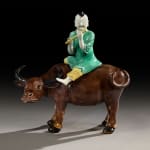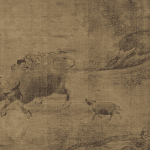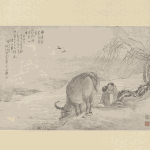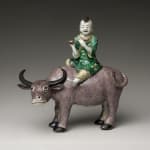
Figure 1. Li Tang (c. 1049 - 1130), handscroll, National Palace Museum, Taipei, Taiwan

Figure 2. Herd-boys and buffalo by the water, Qian Huian, 1907, the Metropolitan Museum of Art, New York (1986.267.81)

Figure 3. The Metropolitan Museum of Art, New York (93.3.292a, b)
A FAMILLE VERTE BOY AND BUFFALO GROUP INCENSE BURNER
Further images
Provenance
Samuel Craft Davis (1871-1940) Collection, St. Louis, Missouri
William Bigler (1908-1979) and Alita Davis (1905-1988) Weaver Collection, Greenwich, Connecticut
Nathaniel Pryor (1933-2018) and Alita Davis Weaver (1941-2023) Reed Collection, Jupiter Island, Florida, and thence by descent within the family
Literature
COMPARE:
Two boy an buffalo groups were exhibited Berlin, Chinesische Kunst, Preußische Akademie der Künste, 10 January - 2 April 1929 (catalogue, p. 347) of which one, R. Bennett Collection, illus. Gorer & Blacker, vol. I (1911), pl. 96
The Metropolitan Museum of Art, New York, another boy and buffalo group (93.3.292a, b)
The theme of boys playing with animals is one of the most enduring and charming motifs of Chinese art. Many animals, whether real or mythical, have an auspicious meaning or are believed to be protective of the boy.1
The water buffalo (shui niu), one of the twelve animals of the Chinese zodiac, symbolises not only strength and patience, but also springtime and agriculture, as the animal used to pull the ploughshare in ricefields throughout China for millenia. It thus also stands for prosperity and hard work.2
A herd-boy riding a buffalo was a popular subject in Song dynasty paintings. This subject matter depicts the natural, bucolic and carefree life of the countryside, far away from ceremony and social obligation. The painting by Li Tang (see above) evokes this rural tranquility. A combination of washed and sharp brushstrokes captures both the buffalo’s form and spirit, which demonstrates palpable affection between it and its offspring following closely behind and boy rider, lying down its back.3 Depicted in this manner, the buffalo was also a symbol of benevolence and submissiveness, as it was able to be obedient to a small child. After work, the boy would take the buffalo to bathe (see above) before returning home on the back of the animal, relaxed and often playing a flute.3
Porcelain models of buffalo and boy rider groups were exhibited in Berlin, Chinesische Kunst, in 1929.4 One of these, from the R. Bennett Collection, was illustrated by Gorer and Blacker in 1911.5 Another example is in the Metropolitan Museum of Art, New York ((93.3.292a, b) (Fig. 3.).
1 Feng-Chun Ma, A Thousand Years of Hundred Boys in Chinese Art, 10th - 20th Century (London, 2024), p. 24
2 Idem.
3 Idem.
4 Chinesische Kunst, Berlin, 1929, p. 347
5 Edgar Gorer & J. F. Blacker, Chinese Porcelain and Hardstones, vol. I (1911), pl. 96




